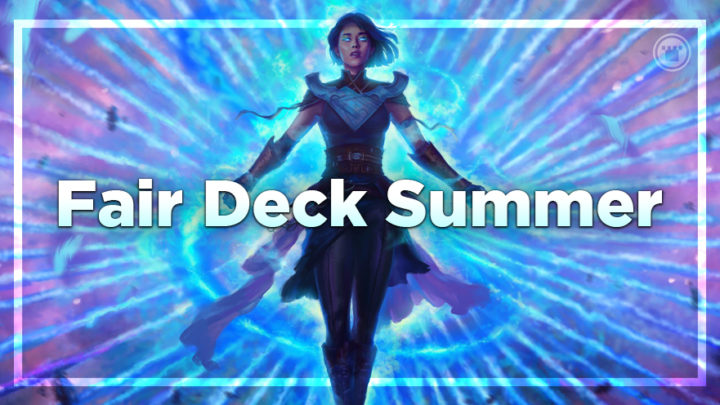Spoiler season for Modern Horizons 2 is like none other in Magic history — save perhaps for the original Modern Horizons. Since every card is explicitly designed for the Modern format, even the commons often require close examination for their potential metagame impact – if not in Modern itself or Legacy, then in Commander or Pauper. No other sets in history have managed the level of impact on Constructed that we saw from MH1, and so far MH2 is on track to meet that standard.
AFTER COMBO WINTER, COMES…
But while most of the initial discussion has focused on the viability of this card or that in a vacuum, zooming out to look at the whole of MH2 spoilers so far shows a surprising trend. Its predecessor shook up Modern by adding cards like Hogaak, Arisen Necropolis, Urza, Lord High Artificer, Echo of Eons, Yawgmoth, Thran Physician — hyper-efficient deck centerpieces which threaten to overwhelm anything an opponent is doing. And many other standouts were also skewed toward explosive combo gameplay — or countering it.
All of this fits with the long-term evolution of Modern, which has become notably faster over the years. Famous, format-defining decks like Jund have struggled to stay relevant as the metagame shifts away from one-for-one trades and toward crushing games in a single blow, and the “crucial turn” for most games comes before turn four.
FAIR DECK SUMMER!
But Modern Horizons 2 seems to buck this trend, consciously so. Almost every card we’ve seen seems designed for the so-called “fair decks”: decks which are slower, interactive, and generally nonlinear in their game plan. Rather than unlocking a specific synergy or offering obvious combo outlets, we’re seeing standalone threats which generate card advantage, or supporting cards which efficiently disrupt opponents and slow down the game.

Nowhere is this better demonstrated than in the choice of Counterspell as the first big spoiler of MH2. There’s a clear contrast to Force of Negation, which has emerged as perhaps MH1’s most important card: despite the defensive slant of Force, it’s still a card which thrives around all-in combo and a generally lightning-fast metagame. After all, the only reason you’d be excited to two-for-one yourself is if you’d risk losing the game otherwise! Counterspell is an attempt to reassert the importance of trading one-for-one with anything; card advantage over tempo as an ethos for Modern. And most of the new MH2 card designs inherit that ethos.
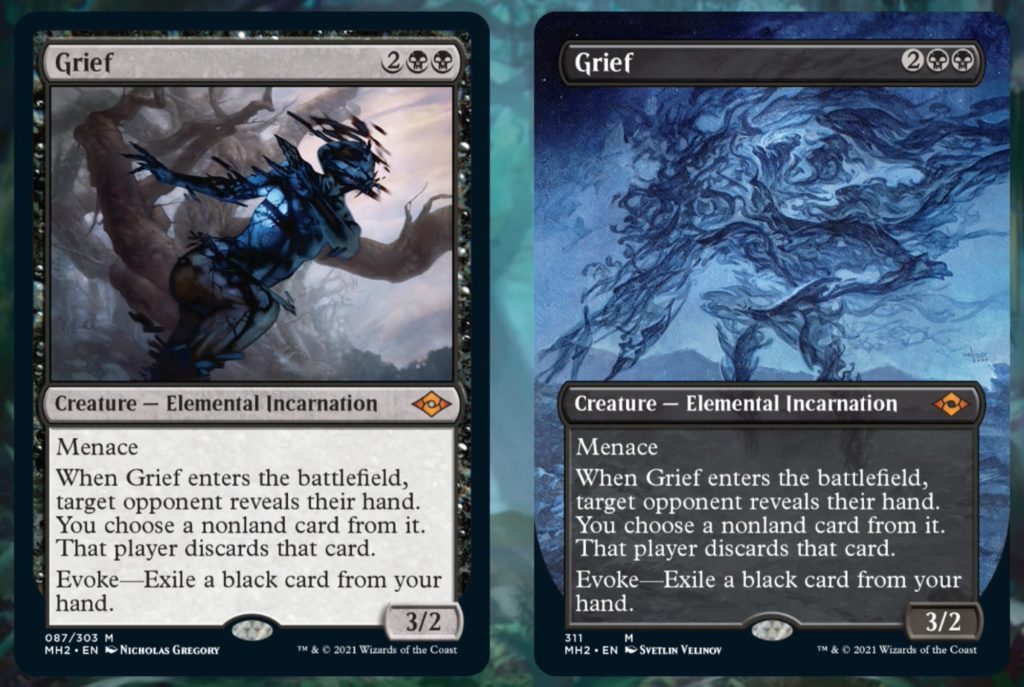
As Force of Negation demonstrates, we don’t typically associate free spells with fair Magic. And it’s possible that we’ll see players use the brute force of Grief to clear a path for turn one combos, the way Unmask has traditionally been used in Legacy Reanimator. But such combo decks are still fewer and far more fragile in Modern, and viewing Grief as “Force of Thoughtseize” like this is only using half its potential. Instead, discussion around this card has focused on combos with Ephemerate, Undying Evil or Malakir Rebirth — positioning it as a weapon for discard-heavy creature value decks like Jund or the WB Flicker list which won this month’s Modern Championship Qualifier. To me, not much says “powerful fair Magic” like evoking Grief while holding up an Eldrazi Displacer activation!
THE DAKKON IS BAKKON
Combining the set’s dominant themes of “fair deck tools” and “creative nostalgia,” the planeswalker re-imagining of cult-fave Dakkon Blackblade brings a multi-faceted threat to Esper decks.
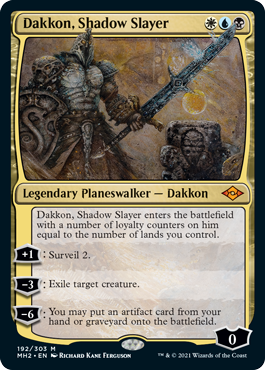
That anachronistic, color-pie-bending “lands matter” clause neatly pushes Dakkon toward control or at least midrange territory, while leaving his actual casting cost at playable levels for the format. Being able to come down early and blast a creature or arrive after six lands to threaten an immediate haymaker like Bolas’s Citadel or Blightsteel Colossus is exactly the sort of flexible, scaling impact that a fair deck wants; the whole concept thrives on cards which will retain their value regardless of game state or available synergies.
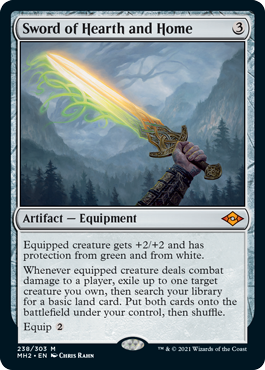
Sword of Hearth and Home epitomizes this same ideal, as you’d expect for the newest entry in the infamous “Sword of X and Y” megacycle. While their blanket two-color protection may be harsh against some decks – particularly in Commander – for Constructed, the Swords are about as fair as you can get. Playing a creature, playing and attaching an equipment to it, and getting in an unblocked attack, all to generate a non-immediate, incremental amount of value? That only makes sense when you’ve got a long-term game plan in mind, and as the first sword since Feast and Famine to double up on value-generating triggers, Hearth and Home could end up as a definitive tech choice for creature-deck mirrors.
KEEPING UP, OR KEEP THEM DOWN?
Given the immutable implications of Magic’s mana system, even the most durdly deck in Modern must do its best to efficiently utilize each untap step. Ramping or playing a cheap threat is often an invitation for more explosive decks to immediately blow past you; that’s why proactive disruption (or at least instant-speed board development) is so very crucial.
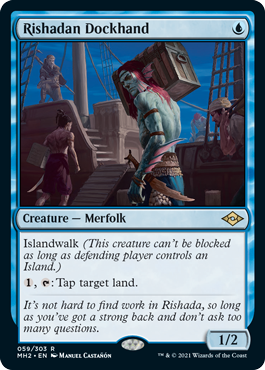
Joining Grief in the former category for MH2 is the intriguingly blue Rishadan Dockhand. I have long campaigned for Rishadan Port in Modern; the ability to commit creatures to play and then tie up opposing mana recreates the role of Armageddon without needing to allow forbidden land destruction techniques back into current Magic. Without this sort of pressure, creature decks are forced to overcommit and increase the pace of games, since to go slower is to give control and midrange decks time to go over the top. WotC clearly doesn’t want to give white-based creature decks access to this kind of tempo in Modern, but perhaps Dockhand’s power will be enough to help Merfolk Tribal find its feet (haha) in the format again.
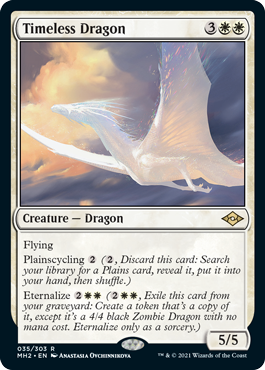
Timeless Dragon is a solid (if straightforward) entry under that second “instant-speed development” column; the kind of card that possibly only I get excited about. Yes, it’s surprisingly simple by MH2’s text-clogged standards. But being able to hold up a couple of mana for Ephemerate or Path and still put it to use setting up an uncounterable flyer is just the kind of thing my beloved clunky white decks need more of — options for efficient reactive play.
Not to mention that, even in an era of MDFC’s and the London Mulligan, it’s still an uphill battle to hit five straight land drops in Mardu colors to cast your midrange finisher. Humble though it may appear, there’s few abilities which would have the same consistent upside as plainscycling in these niche archetypes.
FAIR ISN’T ALWAYS BORING
Fair Magic poster child Death & Taxes generates some very polarized reactions among the player base: some people (me) hold it to be an ideal play style, one where every game threatens to break down into a complex game of inches over many turns. Players more excited by cool combos and playing a ton of spells in one turn may instead view Thalia and her gang as the fun police. Fair Magic is just not seen as being powerful or exciting Magic – and in fact, many people see it as a direct opposite. But I hope Modern Horizons 2 can change that.
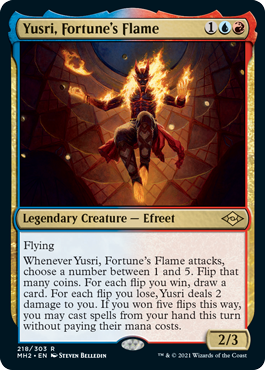
It’s almost impossible to look at a card like Yusri, Fortune’s Flame (or even the reprinted Cabal Coffers) and call it boring. If anything, public perception is more likely to pigeonhole these as “Commander cards”; too wild and adventurous to compete for slots in the hard-nosed world of Modern. But I think both show tournament potential, and furthermore, both are predominantly fair cards played by fair decks!
Yusri will definitely inspire a few brave people to try Krark’s Thumb in Modern, but by and large, his role here is to offer a large return of value for protecting your flying threat in combat. He seems like a significant upgrade in this regard for his colors and mana value, and it will be interesting to see a few copies sneak their way into URx control and tempo lists.
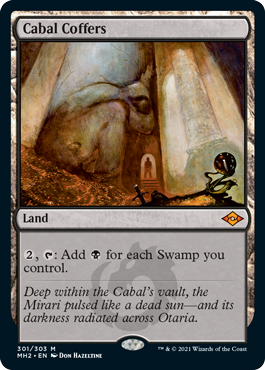
Coffers, meanwhile, is a big-mana engine that’s remarkably hard to cheat your way into, even considering the classic combo with Urborg, Tomb of Yawgmoth. Only Primeval Titan decks have an easy time reaching a high land count quickly while also fetching up those two non-basics — and even then, most lists don’t have an obvious outlet for the surplus black mana! Cabal Coffers is genuinely a temptation to explore mono-black control and finishers like Torment of Hailfire or Tetzimoc, Primal Death — and how much more exciting do you need fair Magic to be?
With these new and refreshed printings taking center stage, Modern Horizons 2 is doing more than any set I can remember to push back against the recent skewing of non-rotating Constructed metagames. While it’s always tricky to combat power creep without further power creep, I strongly support these kinds of interaction-focused designs over the alternative. They create a Modern with longer games, more decisions and more time for different cards to shine. Modern Horizons 2 imagines a brave new world, where it’s Storm players who are the lumbering Dinosaurs of the format – and that’s a future I can get behind.
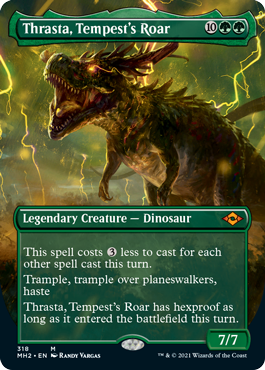

Tom’s fate was sealed in 7th grade when his friend lent him a pile of commons to play Magic. He quickly picked up Boros and Orzhov decks in Ravnica block and has remained a staunch white magician ever since. A fan of all Constructed formats, he enjoys studying the history of the tournament meta. He specializes in midrange decks, especially Death & Taxes and Martyr Proc. One day, he swears he will win an MCQ with Evershrike. Ask him how at @AWanderingBard, or watch him stream Magic at twitch.tv/TheWanderingBard.

